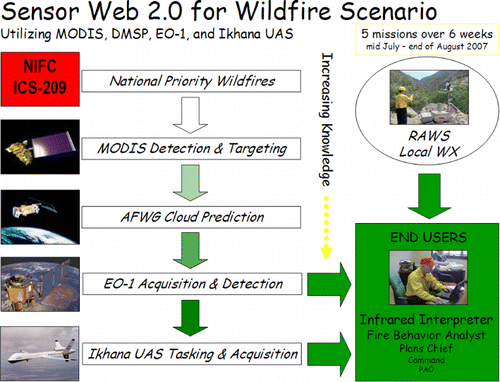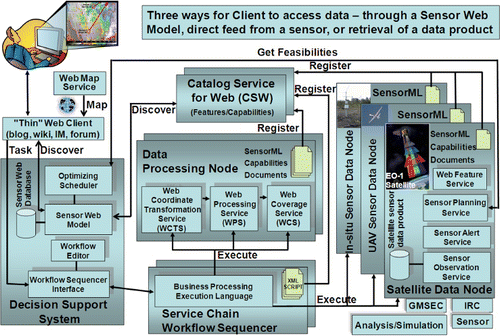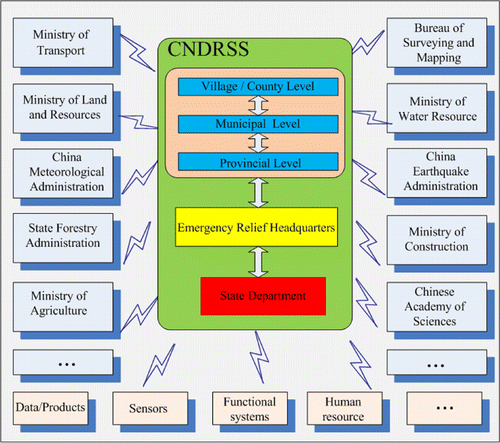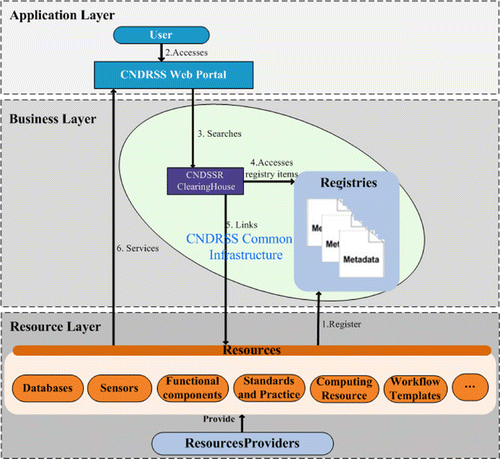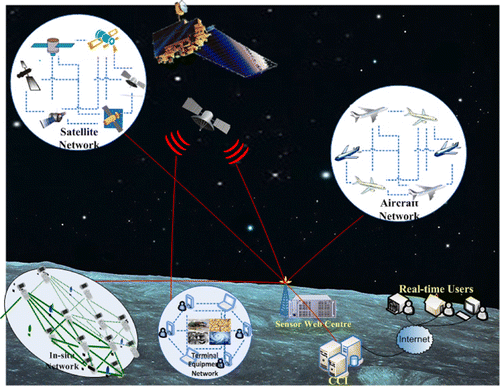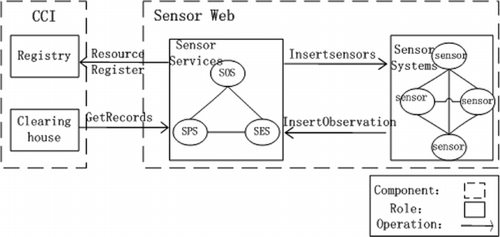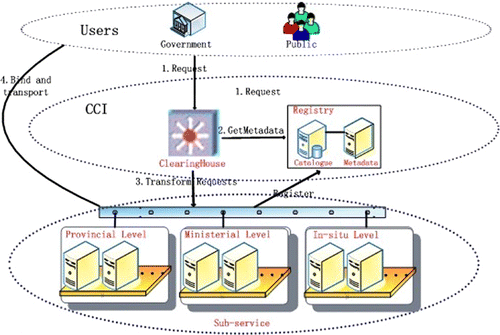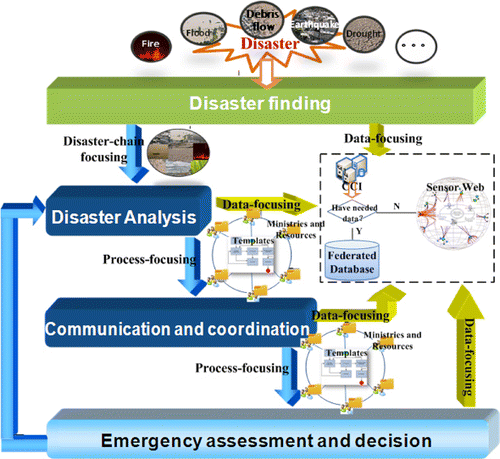Abstract
China is one of the most disaster-prone countries in the world. Currently, the disaster prevention and relief mechanism in China is mainly based on single disaster types and is implemented by different ministries and divisions in single administrative regions. Subsequently, the available resources, including data, services, materials, and human resources, cannot be shared and used effectively. Based on the idea of an observation system of systems and a business system of systems, this paper presents an integrated framework for a Chinese National Disaster Reduction System of Systems (CNDRSS) to address this issue. The CNDRSS framework aims to achieve data sharing and collaboration among different disaster-related ministries/institutions by providing one-stop services for all phases of disaster management and linking together existing and planned disaster-related business systems and observation systems. The key technologies use federated databases and a web service to integrate multiple disaster management systems among different ministries/institutions and a sensor web to integrate airborne, space-borne, and in-situ observations through the web service. These event-driven focused-services connecting the various observations, processing, and mapping processes can meet the requirements for complex disaster-chain systems.
1. Introduction
In recent years, disasters have become more frequent and damaging around the world, posing an increasing challenge for emergency services. Examples include the tsunami in Indonesia in 2004 (Aitkenhead, Lumsdon, and Miller Citation2007), the Wenchuan earthquake in China in 2008 (Li Citation2009), the 2010 Haiti earthquake (Duda and Jones Citation2011; Van Aardt et al. Citation2011), and the flood in Thailand in 2011 (Kridskron et al. Citation2012). How to respond to disasters such as these more quickly and more effectively is a very important problem for scientists, disaster managers, and decision-makers. In order to cope with such complex, large-scale disasters, earth observation agencies, national geo-information agencies, transport ministries, public health and other ministries/institutions must be able to react expeditiously not only on an individual level, but in a highly coordinated manner with other agencies. Accordingly, the need for both intra- and inter-organization coordination at several hierarchical levels is essential (Auf der Heide Citation1989). Since the beginning of the International Decade for Natural Disaster Reduction (Housner Citation1989; ADRC Citation2006), the international community has placed increased emphasis on disaster reduction. The trend in disaster risk reduction is shifting conceptually away from individual case-by-case emergency management toward a holistic approach emphasizing disaster chains, collaboration, and integrated disaster reduction and risk management.
With the rapid development of information technology and 3S technology (Geographic Information Systems, Remote Sensing, and Global Positioning Systems), many countries have built various disaster information systems supporting disaster prevention and relief. Recently, the China Digital Earth Prototype System (Guo, Fan, and Wang Citation2009), the Spatial Data Infrastructure (Craglia et al. Citation2008; Li, Shan, and Gong Citation2009), open geospatial web services discovery (Li, Shan, and Gong Citation2009), the Sensor Web Enablement (SWE) standards (De Longueville et al. Citation2010), and the virtual globe (Butler Citation2006) have been realized and have achieved significant progress toward a ‘Digital Earth.’ However, it is an enormous challenge to create the means to connect individual advanced technologies together and integrate mutually isolated disaster information systems into a disaster-reduction system of systems (SoS) within a cyber-physical environment.
China is experiencing more frequent and intense disasters that are both diverse in nature and widely distributed geographically with heavy losses to life and property. The statistical records (Zhou, Fan, and Yang Citation2010) show that, from 1989 to 2008, natural disasters in China, on average, annually affected about 350 million people. The annual direct economic loss during that period was more than 200 billion RMB. In addition, over 70% of China's cities and over 50% of its population at the present time are located in regions where meteorological, geological, and oceanographic risks are very high. Natural hazards are significantly amplified by urbanization, population growth, global climate change, and economic globalization, all of which heighten an area's vulnerability. For example, because of rapid urbanization, more people and property are threatened by flooding; and by the end of the twenty-first century, 536 of China's 668 cities will be at risk (Gao et al. Citation2007). The large reservoirs built in the last century for preventing drought have created significant flooding risks to the areas around them; droughts in northern China are becoming ever more frequent and severe with climate change; and the overuse of water resources and deforestation are decreasing the ability of soil to store water (Gao et al. Citation2007). Disasters threaten economic development and the livelihood of citizens so conducting high-efficiency disaster prevention and relief is therefore an urgent task facing the Government of China (Konečný Citation2011). Among the problems facing disaster-reduction efforts in China are the following:
Data and information cannot be shared or sufficiently integrated. A salient problem in current disaster prevention and relief is ‘rich in data, barren of information, with lack of knowledge’ (Li, Shan, and Gong Citation2009). Some systems have become ‘isolated information islands.’ Especially, the information from a stricken area cannot be transmitted effectively to disaster mitigation headquarters.
Collaboration among different ministries/institutions is insufficient. The occurrence of one disaster usually precipitates multiple disasters and requires joint efforts and cooperation between various ministries.
The purpose of this paper is to present the framework for a CNDRSS, including design considerations, organization, mechanism, architecture, and components. This paper will also analyze the key technologies needed to build such a CNDRSS. We will build a common infrastructure for CNDRSS, including a register center and a search engine connected to a web portal as well as distributed resources via a service-oriented architecture (SOA) (Perrey and Lycett Citation2003), so that the registered resources can be discovered and accessed through the web portal. Additionally, some useful tools (e.g. workflow management and online risk communication systems for various ministries) will be provided.
The remainder of this paper is organized as follows. Related work is described in Section 2. The architecture and components of the CNDRSS are presented in Section 3 as well as the interactions among the components of CNDRSS, based on an analysis of the requirements and design considerations. Section 4 outlines the key technologies needed: registration for and query of the resources, use of the sensor web to integrate ground, airborne, and space-borne sensors, the federated database, and the event-driven focusing service. Section 5 summarizes the conclusions and outlines further work.
2. Progress in building an SoS concerning the environment and disasters
In this section, we briefly present the progress in building an SoS for monitoring, collecting, and sharing environmental and disaster data, as well as outlining the standards for geographic services and sensor webs.
2.1. Integrated systems
Currently, many multinational and national integrated information platforms for disaster monitoring and risk reduction have been built or will be built in a federal style.
The Group on Earth Observations led the establishment of the Global Earth Observation System of Systems (GEOSS) (http://www.earthobservations.org). This SoS aims to proactively link together existing and planned observing systems around the world. It is intended to support the development of new systems that will fill the gaps that currently exist and, through a portal, will provide an Internet access point for users seeking data, imagery, and analytical software packages relevant to all parts of the globe. The initial construction of GEOSS is complete at this time; and by 2015, the GEOSS expects to achieve sustained operation, continuity, and interoperability of the existing and new systems that provide essential environmental observations and information. This cross-cutting approach avoids unnecessary duplication, encourages synergies between systems, and ensures substantial economic, societal, and environmental benefits (GEOSS Website).
The Global Monitoring for Environment and Security (GMES) (http://copernicus.eu/) system is the European contribution to GEOSS. GMES is a joint initiative of the European Commission and the European Space Agency, which was adopted by the European Union leaders at the Gothenburg Summit in 2001. Over the last 10 years, numerous research and development projects have contributed to the expansion of the GMES infrastructure and services. GMES builds upon four pillars: the space component, (satellites and associated ground segment), in-situ measurements (ground-based and airborne data-gathering networks), data harmonization and standardization, and services to users (Ehlers Citation2008).
The Earth Observing System Clearinghouse (ECHO), developed by the US National Aeronautics and Space Admnistration (NASA), is an operational open system based on Extensible Markup Language (XML); and Web Service technologies is a spatial and temporal metadata registry and order broker built by NASA's Earth Science Data and Information System (http://www.echo.nasa.gov/). It enables the scientific community to more easily use and exchange NASA's data and services. ECHO acts as middleware between data partners and client partners, which provides an SOA environment for the Earth Observing (EO) community. Currently, ECHO has 12 data centers (Bai et al. Citation2007). ECHO, in essence, is a federated database system, focusing on sharing data and services, with little attention to sensor webs or integration with a wide variety of sensor systems to provide real-time or near real-time Sensor Web services.
The German Government established a crisis prevention information system (deNIS) to provide critical spatial risk information. Assisted by the Federal Government and the Länder (German States), it brings together dispersed information in a geographic information system to generate an interactive map with multiple functions (http://www.denis.bund.de/). Essentially, deNIS is a geographic information system.
In Japan, the National Land Agency, which is in charge of disaster prevention administration, developed an integrated emergency management system called the Disaster Information System (DIS). It is a means for quickly determining the extent of damage, thereby enabling the related agencies and authorities to share information. DIS supports quick and accurate decision-making when implementing emergency measures (Miyatake and Nunomura Citation2003).
At present, in China, a number of national integrated basic database systems and comprehensive disaster-related application systems have been established or are under construction, such as the National Natural Resources and Geospatial Basic Information Database, the National Geo-information Public Service Platform, the National Emergency Response Platform systems (at the national, ministerial, and provincial levels), and 12 integrated operational observation systems. The 12 integrated operational and professional observation systems are operated by 12 different professional ministries/organizations in China, which include the Comprehensive Information on Disaster and Observation System (operated by the Ministry of Civil Affairs), the Integrated Agricultural Observation System (operated by the Ministry of Agriculture), the Integrated Hydrological Monitoring System (operated by the Ministry of Water Resources), and the Integrated Meteorological Monitoring Systems (operated by the China Meteorological Administration) (NCDR Citation2009). However, these databases and systems are independently operated and currently there are no effective and sufficient connections among them.
2.2. Standards of federated database and interoperability
The International Standardization Organization (ISO) and the Open GIS Consortium (OGC) have been leading efforts to create heterogeneous data sharing and interoperability standards by developing and releasing a series of standard specifications.
OGC is a not-for-profit organization with more than 210 members. OGCs goal is the ubiquitous access and use of spatial data and spatial processing in an open marketplace (http://www.opengis.org/techno). OGC has been developing, releasing, and promoting a series of common web service architectures and standards for geospatial information interchange and interoperation through its standards program, interoperability program, compliance program, and marketing and communications program. For data services, the most universal OGC protocols for data access are the Web Map Service (de la Beaujardiere Citation2006), Web Feature Services (Vretanos Citation2002), and Web Coverage Services (Lee et al. Citation2005). The Geospatial Catalog Service Web (CSW) profile (Nebert, Whiteside, and Vretanos Citation2007) was designed to provide capabilities for advertising and discovering shared geospatial data and services over the web through the registration of both data and services in a catalog.
ISO-TC211 has published the ISO191XX standards in order to routinize the management of geographic information. Currently, there are 43 projects deployed under the supervision of ISO-TC211 (http://www.iso.org/iso/home.html). These standards may specify geospatial information, methods, tools, and services for data management, acquisition, processing, analyzing, accessing, presenting, and transferring such data in digital/electronic form between different users, systems, and locations (Ostensen and Smits Citation2002). In the early stages, ISO-TC211's efforts concentrated mainly on developing international standards for feature-based geographic information. In 1997, ISO-TC211 started to work on the imagery and gridded data areas through Project 19121, Imagery and Grid Data (Di, Kresse, and Kobler Citation2001).
2.3. Experiment and practice of geospatial Sensor Web
Currently, the OGC's SWE standards enable developers to make various types of sensors, transducers, and sensor data repositories discoverable, accessible, and usable via the web (Botts and Robin Citation2007). In the SWE framework, there are four information models (sensor model language (SensorML); observation and measurements (O&M); transducer markup language; and event pattern markup language) and five service implementation specifications (sensor planning service, sensor observation service, sensor alert service, sensor event service, and web notification service) (Chen et al. Citation2011).
Using a web portal integrated with Sensor Web 2.0 (Mandl et al. Citation2008), a user can trigger workflows that search for available sensors and then direct their actions as the following disaster scenario demonstrates (). A fire-behavior analyst selects wildfires in southern California as the area of interest. NASA's space-based Moderate Resolution Imaging Spectroradiometer (MODIS) data are retrieved for its earth surface observations. For the fire locations detected by MODIS, observation conditions are obtained by the Acquisition Functional Working Group. Then, the Earth Observing 1 (EO-1) satellite Hyperion instrument is automatically triggered to take a higher resolution multispectral image. Automatic triggers also cause an unmanned aerial system to collect more detailed fire imagery. The user receives notifications via instant message, short message service, or other notification services (such as Twitter) when fires are detected in the area of interest and/or when high resolution fire maps derived from one of these sensors are available (Mandl et al. Citation2008). As a result, the fire analyst can focus specifically on the resulting detailed fire map and how to deploy needed resources rather than orchestrating the plethora of available sensors (Mandl et al. Citation2008).
The interoperable Sensor Web consists of an architecture that specifies a set of standards to be used by sensors to integrate into the ‘Internet’ of sensors (see ). In this architecture, sensors are encapsulated as sensor data nodes that can contain self-describing documents using SensorML. The descriptions may include determining location as well as defining the resolution, spectral bands, and swath and how to task the sensor. Data-processing algorithms are encapsulated as data-processing nodes with SensorML or similar Web-accessible documents that describe what the algorithms do. These descriptions may include inputs, outputs, methods employed by the algorithm, and how to invoke the algorithm for user data. These Web-accessible documents are created so that information about the sensors and algorithms can be discovered over the Internet through CSW and provide information on how to access the sensors and algorithms. The user can then assemble sensor data and selected algorithms into a customized workflow or service chain in an automated fashion, which includes automatic electronic delivery of data products to the user's computer desktop, thus enabling on-demand science products. With a Sensor Web, automated workflows and reasoning functions bring together all the required resources into a single functional flow (Mandl et al. Citation2008).
3. Framework of CNDRSS
3.1. Design considerations
China is a country of large land mass and population. Disasters in China are characteristically diverse, frequent, and widely distributed with heavy losses. The disaster-related ministries in China are divided according to professions and regions. They are hierarchical, and different ministries at different levels in different regions take corresponding responsibilities for their areas. As a result, the disaster management and reduction mechanisms are based on single disaster types and conducted by different ministries and divisions within single administrative regions. To solve these existing problems, we must change from this individual case-by-case emergency management approach toward a holistic approach that includes the seamless collaboration of a federated database and disaster-chain analysis with the goal of integrated disaster reduction and risk management. Specifically, we are facing the following tasks (see ):
There must be full and open exchange of data, services, and other resources within the CNDRSS, while recognizing relevant national policies and legislation.
Effective mechanisms and platform for various ministries to work together against disasters must be provided that will interoperate online and share both data and services when communicating and coordinating with each other.
In emergencies, disaster information collected by local branch offices of national governmental organizations must be rapidly delivered to their respective upper-level organizations where the information will be integrated as an aid for decision-making.
Various sensors must be integrated to provide Sensor Web services, especially for real-time or near real-time use.
To fulfill these tasks, CNDRSS must be geographically distributed, interoperable, independent, and flexible.
Geographic Distribution: Due to the objective characteristics of spatial data, which can include spatial distribution and application dissimilarity, data collection and management are usually conducted and maintained by different ministries/organizations in different regions. CNDRSS aims to integrate these systems through interoperability and telecommunication. As a result, its geographic extent is large.
Interoperability: CNDRSS will integrate resources through the Web service by adhering to published interface standards so that the component systems can interoperate and work together. Users can transparently search and access the information and service from the contributors of CNDRSS.
Independence: If CNDRSS is disassembled into its components, essentially independent and useful in their own right, the component systems must be able to operate independently. The component systems must maintain a continuing operational existence independent of CNDRSS.
Flexibility: The architecture of CNDRSS will be loosely coupled based on the SOA. This makes the service independent of the development language, machine, and platform. In addition, CNDRSS is not fully formed; and its development and existence is evolutionary with functions and purposes added, removed, and modified with experience gained so that new systems can be integrated by registering and providing standard interface protocols. In addition, in terms of standards, CNDRSS is flexible: CNDRSS is continuously developing uniform standards, such as interface standards, data formats, naming, etc., to which its components must adhere. In addition, according to the needs and conventions of different industries, standards and norms for a specified industry can be developed, registered, and followed.
3.2. Organization and mechanism
The National Commission for Disaster Reduction (NCDR) is an inter-ministerial coordination body under the leadership of the State Council. The main task of NCDR is to study the development of national disaster-reduction principles, policies, and plans. It coordinates the launch of major disaster-reduction activities, guides local disaster mitigation work, and promotes international exchanges and cooperation for disaster reduction (http://www.jianzai.gov.cn). NCDR includes 34 disaster-related member units, including governmental ministries, military, scientific research departments, and non-governmental organizations. NCDR is responsible for constructing and managing CNDRSS and will coordinate its member units and other related institutions with the full support and cooperation of those units.
To guarantee the successful operation of CNDRSS, NCDR will lead its member unites and relevant experts/institutions to develop relevant standards or specifications for data, interfaces, services, etc. as well as mechanism for collaboration, management, operations and maintenance, communication, and cooperation. CNDRSS's design, construction, operation, and management will be guided by these standards and mechanisms.
3.3. Architecture and components
To achieve the above objectives, there are three layers in the CNDRSS architecture: the Application Layer, the Business Layer, and the Data Layer (see ).
The Application Layer will be the presentation layer for user clients. Its main function will be to obtain user requests through the Web portal and then transfer the requests to the Business Layer. When the responses to requests are received, the results will be presented in a visual frame to the user clients in the form of XML documents, statistical tables and graphs, images, URLs, etc.
The Business Layer will deal with the requests from the Application Layer. The CNDRSS Common Infrastructure (CCI) will support it. CCI will be connected to both the Application Layer and the Resource Layer and will work as a switch center. CCI will provide a catalog service, which will enable discovery and access of registered resources on CNDRSS, thereby providing a well-documented interface for the corresponding resources.
The Resource Layer will be the basis of CNDRSS. The resources include databases, sensors, functional components, standards and practices, computing resources, workflow templates, etc.
3.3.1. Web portal
The CNDRSS Web portal, the primary user interface, aims to allow the user clients to search, discover, and access all CNDRSS resources through a single user interface. Tools will be provided in this layer, such as a visualization system, risk communication system, data pre-processing system, and data order and dissemination system. An important feature of the proposed scheme, the event-driven focusing service, will provide an approach for designing, implementing, and constructing a flexible and live link among specified resources for different event scenarios. Users will be able to search and customize workflow templates through the user portal.
The user group of the proposed CNDRSS is basically divided into two parts: (1) public individuals/organizations and (2) government members. They will have different grades of authority to access different resources or services. The public users will be able to access public services and the resources of CNDRSS members (e.g. real-time disaster risk maps, disaster relief plans, and implementation). In addition, the government members will be users as well as resource providers (e.g. professional companies, research institutions) and will be invited to take part in CNDRSS. The governmental users will mainly include the member units of NCDR.
3.3.2. CCI
Using the design concept of GEOSS for reference (Christian Citation2008), CCI will consist of registries of resources and a clearinghouse (Christian Citation2008, GEOSS Website) for searching resources. The registry will archive all the resource metadata as the generalized description information for the provided resources. The standardized search center (CNDRSS Clearinghouse) will provide for standardized searches across the registered items and catalog services; and the clearinghouse will be used to manage the metadata descriptions for resources in the network to provide a detailed inventory of all registered resources. In addition, as CNDRSS aims to bring various types of resources together, CCI will require integration of the catalogs for various types of resources into a catalog federation for user clients to discover and access relevant resources from a single user interface.
3.3.3. Resource provider
To achieve more efficient and effective disaster-reduction, CNDRSS will bring together disaster-related ministries/organizations (the resource providers) and provide the necessary resources to build a platform for sharing and collaboration. All the resources will be independent of each other as well as CNDRSS, with no interference from other systems or organizations.
3.4. Interaction
CNDRSS will be designed in accordance with the SOA standard. The challenge will be combining the frameworks so that each layer is exposed to each other layer in a loosely coupled manner, regardless of the underlying technologies, so that the three layers of the architecture can communicate and interact with each other through relevant standards and protocols (see ).
3.4.1. Interactions between user clients and CCI
When the user clients pose requests through the user portal, the requests will be transferred to the CCI, and CCI will respond. The CCI Clearinghouse will search the registry to retrieve the relevant registry items and transform the request, and, finally, then dispatch the transformed request to a corresponding resources center.
3.4.2. Interactions between CCI and resource provider
CCI will be responsible for comprehensive resource management. All the resources of CNDRSS will be required to be registered in the registry of CCI, and the metadata of the corresponding resources will be archived to facilitate the discovery and search of the resources. Managing the metadata catalog will require synchronizing files with the registered resources; therefore, once the registered resources are updated or deleted, the corresponding metadata will be renovated or deleted synchronously.
In addition, once CCI receives requests from the Web portal, the clearinghouse will transform and transfer the requests to the resource providers and bind the corresponding resources with the requesting users, all of which will be completely invisible to the user clients so that they will not feel the distribution of resources and complexity of the process.
3.4.3. Interactions between user clients and resource providers
Resource providers will be bonded with the client terminal after the discovery of resources from CCI through the web portal, and then the resource providers will directly provide services to the user clients.
4. Key technologies
In order to integrate the distributed resources among which resource sharing and interoperability can be achieved, various standards and protocols need to be provided. The key technologies concern the registration for and query of resources, the building of the sensor web and the federated database, their integration with CNDRSS, and the implementation of the event-driven focusing service.
4.1. Registration for and query of resources
Resource registration and inquiry will be the core functions of CCI, which will integrate the distributed resources in a loosely coupled manner through the registration and catalog services. The Geospatial metadata catalog service based on the ebXML Registry Information Model (ebRIM) specifies the interfaces, bindings, and framework for defining application profiles and can be adopted by CNDRSS to facilitate the discovery of, and access to, the resources of CNDRSS (Nebert et al. Citation2007). Specifically, CNDRSS faces the following challenges:
Practically, many metadata models need to be available: to meet specific industry needs and respond to the variety of resources, many metadata schemas, instead of one-size-fit-all metadata standard, can be used in developing a metadata database for so many types of resources for different application domains. The resources can be technically, functionally, syntactically, and structurally heterogeneous.
CNDRSS has to provide a convenient interface for easy submission and registration of various resources, as well as a homogeneous, single user interface to enable users to pose queries of various integrated resources.
CNDRSS must be able to match a user request with appropriate resources using relevant metadata.
4.2. Use of Sensor Web to integrate ground-air-space-borne sensors
NASA defines the sensor web as ‘a coordinated observation infrastructure composed of distributed resources that can behave as a single, autonomous, task-able, reconfigurable observing system that provides observed and derived data along with the associated metadata by using a set of standards-based service-oriented interfaces’ (Delin and Jackson Citation1999, Citation2001; Delin Citation2002).
As shown in , CNDRSS also will be a system of sensor systems (Van Zyl, Simonis, and McFerren Citation2009) that integrates heterogeneous sensors, both in-situ and remote-sensing devices, as well as stationary sensors or those attached to mobile platforms, forming a space-air-ground observation web (Craglia et al. Citation2012) providing access to sensors, sensor networks, and corresponding observational data-sets.
The 12 integrated operational and professional observing systems primarily will be integrated by CNDRSS. Most of them have their own disaster monitoring network and operational systems. Some sensor systems are or will be under construction and include the following: (1) various satellite sensors, such as the FY serials meteorological satellites, the China–Brazil Earth Resource Satellite, the Environment and the Disaster Monitoring Small Satellite Constellation (HJ) (there is a ‘2 +1’ Satellite Constellation currently, and a ‘4+4’ Satellite Constellation will be available in three to five years), and remote sensing serial satellites; (2) aircraft sensors (e.g. unmanned aerial vehicles) with which many ministries in various regions are equipped; (3) in-situ sensor systems operated by different systems; and (4) terminal equipment network. The system will be compatible with existing satellite navigation systems, like Beidou Second Generation, GPS, etc. and aims to conduct timely discovery of potential disasters before disaster strikes, rapidly collect on-site disaster information after disasters, and provide effective communications security for the grassroots members of disaster reporters, disaster relief volunteers, and social workers.
As shown in , in accordance with the requests of the users, corresponding diverse sensor observation services can be registered in the registry center in the CCI, scheduled by the data and sensor planning service, and discovered through the CCI clearinghouse (Chen et al. Citation2009). This sensor system of systems can respond to the requests from CCI to provide real-time or near real-time data services by determining what sensors will be in the required place at the appropriate time and invoke these sensors to obtain the required data. Additionally, the sensor web is a main resource for CNDRSS real-time data-updating.
4.3. Federated database
To strengthen data-sharing among various ministries/organizations and to maintain local data-collection, data maintenance, and autonomy, CNDRSS plans to integrate these distributed databases by building a heterogeneous distributed and federated database management system (HDF-DBMS) (Cardenas Citation1987; Sheth and Larson Citation1990). In reality, the data may reside in one single database or in physically-separated databases, managed individually by the same type of DBMS or by different DBMSs (Cardenas Citation1987). This federated database system (FDBS) is a collection of cooperating but autonomous component database systems characterized by distribution, heterogeneity, and autonomy (Sheth and Larson Citation1990).
Currently, a number of databases exist in different ministries and regions in China. In addition, two integrated database systems are under construction:
(1) The National Natural Resource and Geospatial Basic Information Database (NNRGBID). It includes one data center and 11 physically distributed data subcenters: mineral resources, water resources, resources and environmental science, marine and ocean satellites, mapping, forestry resources, satellite remote sensing, meteorology and meteorological satellites, resource satellites, military mapping, and military space resources. The data center was built by the National Development and Reform Commission and the subcenters are constructed and maintained by the relevant ministries. (2) The National Geographic Information Service Platform, which is based on the multiscale national basic geographic information database and has one master node, 31 partial nodes, and 333 information bases.
As shown in , the construction of the whole database system for CNDRSS involves constructing (1) the FDBS central server that archives the centralized spatial and temporal metadata of the data in a distributed database. The central server is part of CCI, through which users are provided a central access path to keep track of the vast data collection from CNDRSS. (2) The sub-servers that are connected with a central server and a response to the central server, which includes the provincial level, ministerial level, and in-situ level. When data in affiliated databases change, the sub-servers will send the updated data to the central server to make relevant modifications. In terms of content, it will include all levels of databases, including the information database and the catalog database. The information database mainly includes the standard specification database, disaster hazard database, disaster-prone environment database, disaster bearing body database, disaster-reduction resources database, disaster-reduction ability database, information exchange database, and disaster-reduction products database.
Data collection and management of such a federated database will be conducted by the appropriate corresponding ministries/institutions. Depending on the data timeliness, the CNDRSS data fall into either the static data or dynamic data categories. Static data are input on a one-time basis into the database and are updated occasionally and regularly, such as the nationwide administrative map, the population distribution map, and contact information for relief organizations. Dynamic data, most of which are local data, will be updated in real-time periodically, for instance, real-time weather data, the river flow, and the disaster risk map.
4.4. Event-driven focusins service
CNDRSS will serve as a steward of a set of related resources. Ministries collect and document data and information to conduct normal disaster monitoring and release disaster information to the public. During an emergency response, a tremendous amount of information is needed and information and services at different levels are required. This information is often scattered, though, in various ministries/organizations and exists at different stages of development. A means to quickly and effectively collect the needed information and obtaining integrated information is essential. The application layer of CNDRSS will provide an event-driven focusing service oriented to the disaster chain and disaster-reduction process.
The focusing service (Yang et al. Citation2010), a kind of tailored service, has two aspects. The first aspect focuses on the required information by automatic filtration and classification, while the other focuses on the service objects: the disaster-chain and the disaster-reduction process. As shown in , CNDRSS will automatically and sequentially bring the disaster-related ministries and the resources from corresponding ministries together through relevant templates for the workflow, the collection of the resources, and the composition of the services. Templates will not only be registered and constantly improved and updated as resources in CCI, but also will be customized and generated through the Application Layer.
5. Conclusion and outlook
Building a CNDRSS is a long-term process. It will occur in two stages. In the first stage, in five years, demonstration applications will be carried out in five to 10 selected provinces, involving at least 200,000 disaster reporters covering these demonstration provinces and 12 ministries in charge of the 12 integrated observing systems. In the second stage, in another five years, the aim is to cover all provinces as well as all disaster-related ministries in China with at least 720,000 disaster reporters all over China.
This paper proposes a total scheme of CNDRSS from the macro level, including the framework and the key technologies, in the hope that it will provide valuable reference to the government. CNDRSS is a massive project, however, and there are a lot of difficulties to overcome in many aspects of it.
Ensuring efficient, stable, and secure data transmission given the chaotic nature of disasters when infrastructure is destroyed.
Providing efficient collaborative working mechanisms concerning certain laws or policies. CNDRSS involves numerous ministries/ institutions and individuals. The challenge is to make them work together effectively, and the level of cooperation will determine CNDRSS's effectiveness.
Providing a universal metadata model to hide the complexity and diversity of integrated databases and systems.
Acknowledgments
This work was supported in part by the National Basic Research Program of China (973 Program) under Grant 2012CB719904. We sincerely thank Mr. Steve McClure for honing the language and the anonymous reviewers for their valuable comments and insightful input.
References
- ADRC (Asian Disaster Reduction Center). 2006. “Natural Disasters Data Book-2005.” Accessed December 10, 2011. http://www.adrc.asia/publications/databook/DB2005_e.html
- Aitkenhead, M. J., P. Lumsdon, and D. R. Miller. 2007. “Remote Sensing-based Neural Network Mapping of Tsunami Damage in Aceh, Indonesia.” Disasters 31 (3): 217–226. doi: 10.1111/j.1467-7717.2007.01005.x.
- Auf der Heide. 1989. Disaster Response: Principles of Preparation and Coordination. St. Louis, MO: CV Mosby and Co.
- Bai, Y., L. Di, A. Chen, Y. Liu, and Y. Wei. 2007. “Towards a Geospatial Catalogue Federation Service.” Photogrammetric Engineering and Remote Sensing 73 (6): 699–708. http://asprs.org/a/publications/pers/2007journal/june/2007_jun_699-708.pdf.
- Botts, M., and A. Robin. 2007. OpenGIS® Sensor Model Language Implementation Specification, version 1.0.0, OGC®07-000. Wayland, MA: Open Geospatial Consortium.
- Butler, D. 2006. “Virtual Globes: The Web-wide World.” Nature 439 (7078): 776–778. doi: 10.1038/439776a.
- Cardenas, A. F. 1987. “Heterogeneous Distributed Database Management: The HD-DBMS.” Proceeding of IEEE 75 (5): 588–600. doi: 10.1109/PROC.1987.13775.
- Chen, N., Z. Chen, L. Di, and J. Gong. 2011. “An Efficient Method for Near-Real-Time on-Demand Retrieval of Remote Sensing Observations.” IEEE Journal of Selected Topics in Applied Earth Observations and Remote Sensing 4 (3): 615–625. doi: 10.1109/JSTARS.2011.2109035.
- Chen, N., L. Di, G. Yu, J. Gong, and Y. Wei. 2009. “Use of ebRIM Based CSW with Sensor Observation Services for Registry and Discovery of Remote-sensing Observations.” Computers & Geosciences 35 (2): 360–372. doi: 10.1016/j.cageo.2008.08.003.
- Christian, E. J.. 2008. “GEOSS Architecture Principles and the GEOSS Clearinghouse.” IEEE Systems Journal 2 (3): 333–337. doi: 10.1109/JSYST.2008.925977.
- Craglia, M., K. D. Bie, D. Jackson, M. Pesaresi, G. Remetey-Fülöpp, C. Wang, A. Annoni, et al. 2012. “Digital Earth 2020: Towards the Vision for the Next Decade.” International Journal of Digital Earth 5 (1): 4–21. doi: 10.1080/17538947.2011.638500.
- Craglia, M., M. F. Goodchild, A. Annoni, G. Camara, M. Gould, W. Kuhn, D. Mark. 2008. “Next-generation Digital Earth: A Position Paper from the Vespucci Initiative for the Advancement of Geographic Information Science.” International Journal of Spatial Data Infrastructures Research 3: 146–167. http://dx.doi.org/10.2902/1725-0463.2008.03.art9.
- De la Beaujardiere, J. 2006. OpenGIS® Web Map Server Implementation Specification, version 1.3.0, OGC®06-042. Wayland, MA: Open Geospatial Consortium.
- DeLaurentis, D. 2007. ‘Role of Humans in Complexity of a System of Systems.’ In Digital Human Modeling, edited by V.G. Duffy, 363–371. Berlin: Springer-Verlag.
- Delin, K. A. 2002. “The Sensor Web: A Macro-Instrument for Coordinated Sensing.” Sensors 2 (7): 270–285. doi: 10.3390/s20700270.
- Delin, K. A., and S. P. Jackson 1999. “Sensor Webs, NASA Tech Briefs.” Accessed December 10, 2011. http://www.nasatech.com/Briefs//Oct99/NPO20616.html
- Delin, K. A., and S. P. Jackson. 2001. “The Sensor Web: A New Instrument Concept.” InProceedings of the SPIE International of Optical Engineering, 1–9. January 20–26 .
- De Longueville, B., A. Annoni, S. Schade, N. Ostlaender, and C. Whitmore. 2010. “Digital Earth's Nervous System for Crisis Events: Real-time Sensor Web Enablement of Volunteered Geographic Information.” International Journal of Digital Earth 3 (3): 242–259. doi: 10.1080/17538947.2010.484869.
- Di, L., W. Kresse, and B. Kobler. 2001. “The New ISO TC211 Standard Project on Sensor and Data Models for Imagery and Gridded Data.” InInternational Geo-science and Remote Sensing Symposium, IEEE, 1188–1190. July 9–13 .
- Duda, K. A., and B. K. Jones. 2011. “USGS Remote Sensing Coordination for the 2010 Haiti Earthquake.” Photogrammetric Engineering and Remote Sensing 77 (9): 899–907. http://apps.webofknowledge.com/full_record.do?product=WOS&search_mode=GeneralSearch&qid=1&SID=2B@nEhNnn37b3Cj4G9O&page=1&doc=1.
- Effelsberg, W., and M. V. Mannino. 1984. “Attribute Equivalence in Global Schema Design for Heterogeneous Distributed Databases.” Information Systems 9 (3–4): 237–240. doi: 10.1016/0306-4379(84)90006-1.
- Ehlers, M. 2008. “Geoinformatics and Digital Earth Initiatives: A German Perspective.” International Journal of Digital Earth 1 (1): 17–30. doi: 10.1080/17538940701781975.
- Gao, Q., G. Nie, Y. Zhang, and H. Liu. 2007. Disaster Reduction Requirement and Comprehensive Disaster Reduction in China. Beijing: China Meteorological Press (In Chinese).
- Guo, H., X. Fan, and C. Wang. 2009. “A Digital Earth Prototype System: DEPS/CAS.” International Journal of Digital Earth 2 (1): 3–15. doi: 10.1080/17538940902746512.
- Housner, G. W. 1989. “An International Decade of Natural Disaster Reduction: 1990–2000.” Natural Hazards 2 (1): 45–75. doi: 10.1007/BF00124757.
- Konečný, M. 2011. ‘Political and Legislative Approaches to Early Warning and Crises Management.’ In Geoinformation Support for Flood Management in China and the Czech Republic, edited by M. Konečný, E. Mulíčková, P. Kubíček, and J. Li, 110–121. Brno: Masarykova univerzita.
- Kridskron, A., N. Chen, C. Peng, C. Yang, and J. Gong. 2012. “Flood Detection and Mapping of the Thailand Central Plain Using RADARSAT and MODIS Under a Sensor Web Environment.” International Journal of Applied Earth Observation and GeoInformation 14 (1): 245–255.
- Lee, E., M. Kim, M. Kim, and I. Joo. 2005. “A Web Services Framework for Integrated Geospatial Coverage Data.” Journal of Lecture Notes in Computer Science 3481 (2005): 1136–1145. doi: 10.1007/11424826_121.
- Li, D. 2009. “Remote Sensing in the Wenchuan Earthquake.” Photogrammety Engineering & Remote Sensing 75 (5): 506–509. http://apps.webofknowledge.com/full_record.do?product=WOS&search_mode=Refine&qid=5&SID=2B@nEhNnn37b3Cj4G9O&page=1&doc=10.
- Li, D., J. Shan, and J. Gong. 2009. Geospatial Technology for Earth Observation, New York: Springer.
- Liu, S. 2011. “Employing System of Systems Engineering in China's Emergency Management.” IEEE Systems Journal 5 (2): 298–308. doi: 10.1109/JSYST.2011.2139350.
- Maier, M. W. 1988. “Architecting Principles for Systems of Systems.” Systems Engineering 1 (4): 267–284. doi: 10.1002/(SICI)1520-6858(1998)1:4%3C267::AID-SYS3%3E3.0.CO;2-D.
- Mandl, D., P. Cappelaere, S. Frye, R. Sohlberg, L. Ong, S. Chien, D. Tran, et al. 2008. “Sensor Web 2.0: Connecting Earth's Sensors via the Internet.” NASA Earth Science Technology Office (ESTO) Conference, June 24–26 . Accessed December 10, 2011. http://www.esto.nasa.gov/conferences/estc2008/papers/Mandl_Daniel_A8P1.pdf
- Miyatake, H., and A. Nunomura. 2003. “General Overviews and Future Perspectives of Disaster Information Systems in Japan.” Proceedings of the 35th Joint Meeting of U.S.–Japan Panel on Wind and Seismic Effects, 05 12–14 . Accessed December 10, 2011. http://www.pwri.go.jp/eng/ujnr/joint/35/paper/51miyata.pdf
- Mostafavi, A., D. M. Abraham, D. A. DeLaurentis, and J. Sinfield. 2011. “Exploring the Dimensions of Systems of Innovation Analysis: A System of Systems Framework.” IEEE Systems Journal 5 (2): 256–265. doi: 10.1109/JSYST.2011.2131050.
- NCDR National Commission for Disaster Reduction. 2009. China Integrated Earth Observation System (Ten-Year Plan). NCDR: Beijing.
- Nebert, D., A. Whiteside, and P. Vretanos. 2007. OGCTM Catalogue Services Specification, version 2.0.2, OGC®07-006r1. Wayland, MA: Open Geospatial Consortium.
- Ostensen, O. A., and P. C. Smits. 2002. “ISO/TC211: Standardization of Geographic Information and Geo-informatics.” International Geo-science and Remote Sensing Symposium (IGARSS 2002), Toronto, Canada, June 24–28 .
- Perrey, R., and M. Lycett. 2003. “Service-oriented Architecture.” Proceedings 2003 symposium on applications and the internet workshops, Orlando, USA, January 27–31 .
- Sheth, A. P., and J. A. Larson. 1990. “Federated Database Systems for Managing Distributed Heterogeneous and Autonomous Databases.” ACM Computing Surveys 22 (3): 183–236. doi: 10.1145/96602.96604.
- Van Aardt, J. A. N., D. Mckeown, J. Faulring, N. Raqueno, M. Casterline, C. Renschler, R. Eguchi, et al. 2011. “Geospatial Disaster Response During the Haiti Earthquake: A Case Study Spanning Airborne Deployment, Data Collection, Transfer, Processing, and Dissemination.” Photogrammetric Engineering and Remote Sensing 77 (9): 943–952. http://apps.webofknowledge.com/full_record.do?product=WOS&search_mode=GeneralSearch&qid=9&SID=2B@nEhNnn37b3Cj4G9O&page=1&doc=1.
- Van Zyl, T. L., I. Simonis, and G. McFerren. 2009. “The Sensor Web: Systems of Sensor Systems.” International Journal of Digital Earth 2 (1): 16–30. doi: 10.1080/17538940802439549.
- Vretanos, P. A. 2002. OGCTM Web Feature Service Implementation Specification, version 1.0.0, OGC®02-058. Wayland, MA: Open Geospatial Consortium.
- Yang, Q., F. Sui, S. Deng, Q. Liu, and Y. Zhou. 2010. “A Method of Information Resource Focusing Service based on Subject Analysis.” Science Technology, and Engineering 10 (19): 4813–4822. (In Chinese). http://d.wanfangdata.com.cn/periodical_kxjsygc201019051.aspx
- Zhou, M., Y. Fan, and S. Yang. 2010. Natural Disaster Risk Management and Warning System. Beijing: Science Press. (In Chinese).

